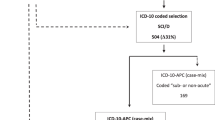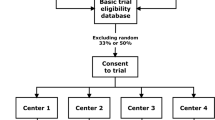Abstract
Study Design:
Observational cohort comparison.
Objectives:
To compare the previously validated Spine Adverse Events Severity system (SAVES) with International Classification of Diseases, Tenth Revision codes (ICD-10) codes for identifying adverse events (AEs) in patients with traumatic spinal cord injury (TSCI).
Setting:
Quaternary Care Spine Program.
Methods:
Patients discharged between 2006 and 2010 were identified from our prospective registry. Two consecutive cohorts were created based on the system used to record acute care AEs; one used ICD-10 coding by hospital coders and the other used SAVES data prospectively collected by a multidisciplinary clinical team. The ICD-10 codes were appropriately mapped to the SAVES. There were 212 patients in the ICD-10 cohort and 173 patients in the SAVES cohort. Analyses were adjusted to account for the different sample sizes, and the two cohorts were comparable based on age, gender and motor score.
Results:
The SAVES system identified twice as many AEs per person as ICD-10 coding. Fifteen unique AEs were more reliably identified using SAVES, including neuropathic pain (32 × more; P<0.001), urinary tract infections (1.4 × ; P<0.05), pressure sores (2.9 × ; P<0.001) and intra-operative AEs (2.3 × ; P<0.05). Eight of these 15 AEs more frequently identified by SAVES significantly impacted length of stay (P<0.05). Risk factors such as patient age and severity of paralysis were more reliably correlated to AEs collected through SAVES than ICD-10.
Conclusion:
Implementation of the SAVES system for patients with TSCI captured more individuals experiencing AEs and more AEs per person compared with ICD-10 codes. This study demonstrates the utility of prospectively collecting AE data using validated tools.
Similar content being viewed by others
Log in or create a free account to read this content
Gain free access to this article, as well as selected content from this journal and more on nature.com
or
References
Krueger H, Noonan VK, Trenaman LM, Joshi P, Rivers C . The economic burden of traumatic spinal cord injury in Canada. Chronic Dis Inj Can, (Submitted).
Street JT, Noonan VK, Cheung A, Fisher CG, Dvorak MF . Incidence of acute care adverse events and long-term health related quality of life in patients with traumatic spinal cord injury. Spine J, (Submitted).
Jaglal SB, Munce SE, Guilcher SJ, Couris CM, Fung K, Craven BC et al Health system factors associated with rehospitalizations after traumatic spinal cord injury: a population-based study. Spinal Cord 2009; 47: 604–609.
World Health Organization. International Classification of Diseaseshttp://www.who.int/classifications/icd/en/ accessed 20 November 2011.
McCarthy EP, Iezzoni LI, Davis RB, Palmer RH, Cahalane M, Hamel MB et al Does clinical evidence support ICD-9-CM diagnosis coding of complications? Med Care 2000; 38: 868–876.
Katznelson R, Djaiani G, Tait G, Wasowicz M, Sutherland AM, Styra R et al Hospital administrative database underestimates delirium rate after cardiac surgery. Can J Anaesth 2010; 57: 898–902.
Campbell PG, Malone J, Yadla S, Chitale R, Nasser R, Maltenfort MG et al Comparison of ICD-9-based, retrospective, and prospective assessments of perioperative complications: assessment of accuracy in reporting. J Neurosurg Spine 2011; 14: 16–22.
Street JT, Lenehan BJ, DiPaola CPB, Boyd MD, Kwon BK, Paquette SJ et al Morbidity and mortality of major adult spinal surgery. a prospective cohort analysis of 942 consecutive patients. Spine J 2012; 12: 22–34.
Rampersaud YR, Neary MA, White K . Spine adverse events severity system: content validation and interobserver reliability assessment. Spine (Phila Pa. 1976) 2010; 35: 790–795.
Canadian Institute for Health Information. Discharge Abstract Databasehttp://www.cihi.ca/CIHI-ext-portal/internet/en/document/types+of+care/hospital+care/acute+care/services_dad accessed 20 February 2012.
Dimar JR, Fisher C, Vaccaro AR, Okonkwo DO, Dvorak M, Fehlings M et al Predictors of complications after spinal stabilization of thoracolumbar spine injuries. J Traum 2010; 69: 1497–1500.
Nasser R, Yadla S, Maltenfort MG, Harrop JS, Anderson DG et al Complications in spine surgery. J Neurosurg Spine 2010; 13: 144–157.
Dekutoski MB, Norvell DC, Dettori JR, Fehlings MG, Chapman JR . Surgeon perceptions and reported complications in spine surgery. Spine (Phila Pa. 1976) 2010; 35: S9–S21.
Faciszewski T, Winter RB, Lonstein JE, Denis F, Johnson L . The surgical and medical perioperative complications of anterior spinal fusion surgery in the thoracic and lumbar spine in adults. a review of 1223 procedures. Spine (Phila Pa. 1976) 1995; 20: 1592–1599.
Rampersaud YR, Moro ER, Neary MA, White K, Lewis SJ, Massicotte EM et al Intraoperative adverse events and related postoperative complications in spine surgery: implications for enhancing patient safety founded on evidence-based protocols. Spine (Phila Pa. 1976) 2006; 31: 1503–1510.
Acknowledgements
We thank Claire Rigter, Judy Farina and Shelda Hall for their assistance mapping ICD-10 codes to AE; Juliet Batke for her contributions to organizing and managing SAVES data; and all the members of the Combined Neurosurgical and Orthopedic Spine Program for their time and effort in collecting the SAVES data.
Author information
Authors and Affiliations
Corresponding author
Ethics declarations
Competing interests
VKN, NPT, AC and JC are employees of the Rick Hansen Institute. MFD consults for the Rick Hansen Institute. JTS and CGF have no conflicts of interest related to this work.
Additional information
Supplementary Information accompanies the paper on the Spinal Cord website
Rights and permissions
About this article
Cite this article
Street, J., Thorogood, N., Cheung, A. et al. Use of the Spine Adverse Events Severity System (SAVES) in patients with traumatic spinal cord injury. A comparison with institutional ICD-10 coding for the identification of acute care adverse events. Spinal Cord 51, 472–476 (2013). https://doi.org/10.1038/sc.2012.173
Received:
Revised:
Accepted:
Published:
Issue date:
DOI: https://doi.org/10.1038/sc.2012.173
Keywords
This article is cited by
-
Hospital spending and length of stay attributable to perioperative adverse events for inpatient hip, knee, and spine surgery: a retrospective cohort study
BMC Health Services Research (2023)
-
Adverse events in spine surgery: a prospective analysis at a large tertiary center in Germany
Acta Neurochirurgica (2023)
-
Revision surgery and mortality following complex spine surgery: 2-year follow-up in a prospective cohort of 679 patients using the Spine AdVerse Event Severity (SAVES) system
Spine Deformity (2020)
-
International Spinal Cord Injury: Spinal Interventions and Surgical Procedures Basic Data Set
Spinal Cord (2015)
-
Reliability of the spine adverse events severity system (SAVES) for individuals with traumatic spinal cord injury
Spinal Cord (2014)



